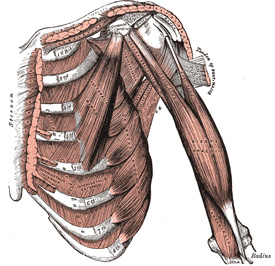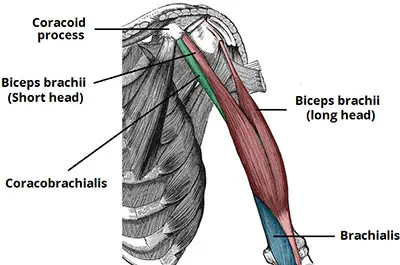Shoulder Muscles used in Piano Playing
The shoulder embraces a group of eight muscles, five of which are directly attached to the shoulder-girdle and the trunk. Through their combined action the shoulder-girdle may be raised (shrugged), lowered, brought forward or backward, and circumducted[1]. The muscles moving the shoulder girdle are trunk muscles situated in the neck, chest, and back, not in the shoulder itself. The muscles in the shoulder itself move the upper-arm and not the shoulder .

Function of the Trapezius
One of the largest muscles of shoulder-movement (trapezius) is situated in the upper central region of the back.
Its function is to draw the shoulder-blade backwards and upwards. By a combination of opposite actions of various bundles of fibers of this muscle, the shoulder socket may be rotated, permitting the arm to be raised in a forward direction above the head.
Another muscle (latissimus dorsi) is situated lower in the back and besides controlling inspiration[2] at the lungs, also adducts and rotates the upper arm. A smaller muscle levator scapulae [3] raises the shoulder-blade, whereas the two rhomboid muscles control the inner end of the shoulder-blade.

What are the Five Muscles of the Shoulder?
The five muscles of the shoulder are:
- Deltoid
- Supraspinatus
- Infraspinatus
- Teres Minor
- Subscapularis
Five Muscles of the Shoulder
In the shoulder proper there are five muscles, of which the deltoid, which forms the fleshy outside covering of the shoulder-socket, is the largest . The main action of the deltoid muscle is to raise the arm from the side and to bring the upper arm into a horizontal position. The front portion of the muscle assists also in drawing the arm forward and the back portion in drawing it backward. This divisior of function is quite characteristic of muscles, and is one of the strongest arguments against the fallacy of teaching muscle-isolation in the various pianistic touches.
Two smaller muscles (the supraspinatus[4] and infraspinatus) assist the deltoid in its actions, the former in arm-abduction and the latter in drawing the arm back at the shoulder-joint. Two remaining muscles (teres minor and teres major) are rotators of the upper arm.

The labeled components are:
-
Coracoid Process
- A small hook-like bony projection on the scapula (shoulder blade) where several muscles attach, including the short head of the biceps brachii and the coracobrachialis.
-
Biceps Brachii (Short Head)
- One of the two heads of the biceps brachii muscle, originating from the coracoid process. It merges with the long head to form the biceps muscle, which functions in elbow flexion and forearm supination.
-
Biceps Brachii (Long Head)
- The other head of the biceps brachii, originating from the supraglenoid tubercle of the scapula. It runs through the intertubercular groove before joining the short head in the arm.
-
Coracobrachialis
- A muscle that originates from the coracoid process and inserts into the humerus. It assists in flexion and adduction of the arm at the shoulder joint.
-
Brachialis
- A deep muscle located underneath the biceps brachii. It originates from the humerus and inserts into the ulna. The brachialis is a primary flexor of the elbow, generating significant force.
Shoulder movement
In any shoulder movement, more than one muscle is usually involved;
Moreover, if the movement be extensive, the action of one muscle is superseded by that of another without the interposition of any break. The transition is gradual, and is often present also in movements of small range. It accords with the skeletal movements described previously. These have shown the gradual shift of mechanical work during the course of a single movement.
- two contribute to abduction (right hand ascending along the keyboard),
- seven, exclusive of the action of gravity, to adduction (right hand descending along the keyboard),
- five each to forward and to backward movement (shift from white to black keys and reverse),
- three to lateral rotation and four to medial rotation.
Moreover, if the movement be extensive, the action of one muscle is superseded by that of another without the interposition of any break. The transition is gradual, and is often present also in movements of small range. It accords with the skeletal movements described previously. These have shown the gradual shift of mechanical work during the course of a single movement.
[1]circumduction: movement of a limb or extremity so that the distal end describes a circle while the proximal end remains fixed
[2]inspiration: The first phase is called inspiration, or inhaling. When the lungs inhale, the diaphragm contracts and pulls downward. At the same time, the muscles between the ribs contract and pull upward. This increases the size of the thoracic cavity and decreases the pressure inside.
[3]levator scapulae: is a skeletal muscle situated at the back and side of the neck.
As the Latin name suggests, its main function is to lift the scapula.
[4]supraspinatus: (plural supraspinati, from Latin supraspinatus) is a relatively small muscle of the upper back that runs from the supraspinatous fossa superior of the scapula (shoulder blade) to the greater tubercle of the humerus.
It is one of the four rotator cuff muscles and also abducts the arm at the shoulder. The spine of the scapula separates the supraspinatus muscle from the infraspinatus muscle, which originates below the spine.